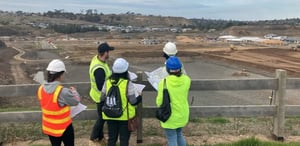 In the quest for heightened operational efficiency, businesses are increasingly turning to the integration of management systems such as ISO 45001, which focuses on Occupational Health and Safety, ISO 9001, which emphasises Quality Management, and ISO 14001, centered around Environmental Management. By weaving these standards into a cohesive, unified management system, organisations can effectively streamline their processes, cut down on redundancy, and enhance their overall performance. This integration not only simplifies the complexity associated with audits and reporting but also fortifies the organisation's ability to manage risks, ensure compliance, and foster a culture of continual improvement. By adopting this holistic approach, businesses can better align their strategic objectives with operational practices, thereby driving sustainable growth and resilience in an ever-evolving marketplace. The implementation of such integrated systems reflects a commitment to not only meet but exceed industry standards, paving the way for innovative solutions that are both effective and ethically sound.
In the quest for heightened operational efficiency, businesses are increasingly turning to the integration of management systems such as ISO 45001, which focuses on Occupational Health and Safety, ISO 9001, which emphasises Quality Management, and ISO 14001, centered around Environmental Management. By weaving these standards into a cohesive, unified management system, organisations can effectively streamline their processes, cut down on redundancy, and enhance their overall performance. This integration not only simplifies the complexity associated with audits and reporting but also fortifies the organisation's ability to manage risks, ensure compliance, and foster a culture of continual improvement. By adopting this holistic approach, businesses can better align their strategic objectives with operational practices, thereby driving sustainable growth and resilience in an ever-evolving marketplace. The implementation of such integrated systems reflects a commitment to not only meet but exceed industry standards, paving the way for innovative solutions that are both effective and ethically sound.
Why Management Systems Integration Makes Sense
Combining these management systems enables an organisation to:
1. Streamline Audits: Instead of conducting separate audits for each system, an integrated audit can assess quality, environmental, and safety aspects at once, reducing time, cost, and administrative burden.
2. Reduce Redundancy: Many processes and controls across ISO 45001, 9001, and 14001 are similar. For example, risk assessment, training, and performance evaluation processes can be consolidated to avoid duplication.
3. Improved Consistency: Integrated systems provide a unified approach to management, ensuring that objectives across safety, quality, and environment are aligned with the organisation’s overall strategy.
Key Considerations for Integration
1. Aligning Common Processes:
All three standards share similar core elements, such as:
- Risk Management: Both ISO 45001 and ISO 14001 focus heavily on identifying and managing risks. ISO 9001 also addresses risks, especially in terms of quality performance. A unified risk assessment process can address safety, environmental, and quality risks simultaneously.
- Leadership and Commitment: Leadership involvement is critical in all three systems. Aligning leadership engagement across these areas helps create a stronger culture of safety, quality, and environmental stewardship.
- Continual Improvement: All three standards emphasise continual improvement. By integrating the processes, an organisation can use the same tools for identifying, monitoring, and improving across safety, environmental, and quality issues.
2. Documenting the Management System:
The integration process often begins with combining the documentation from the individual systems into one management framework:
- Policies and Objectives: Develop a unified policy that encompasses the quality, environmental, and safety objectives. This helps create coherence and ensures the management system aligns with the organisation’s overall strategy.
- Procedures and Work Instructions: Many procedures can be streamlined. For example, risk assessments, audits, and training programs for staff can be combined across the three systems.
3. Harmonising Audits and Reviews:
Internal audits and management reviews for ISO 45001, 9001, and 14001 can be conducted together. This not only saves time but also helps to ensure that the interdependencies between quality, safety, and environmental aspects are managed effectively:
- Audit Scope: Instead of treating audits as separate exercises, develop a combined audit scope that covers all three areas. The combined review process can evaluate how well the organisation is performing in relation to safety, environmental protection, and product/service quality.
- Performance Indicators: Use shared key performance indicators (KPIs) that can reflect performance across safety, quality, and environmental concerns. For instance, a KPI on training compliance can address both safety training (ISO 45001) and environmental awareness (ISO 14001).
4. Leveraging Common Tools and Resources:
Tools such as risk registers, corrective action databases, and performance monitoring systems can be used across the three standards. This not only ensures consistency but also reduces the workload on teams:
- Risk Registers: Use a combined risk register that tracks risks related to safety, quality, and the environment. This ensures that risks are not assessed in isolation, leading to more comprehensive and aligned mitigation strategies.
- Corrective Actions: One platform can manage corrective actions from all areas (quality, safety, and environmental audits), ensuring that the root causes of issues are addressed in a systematic way.
5. Training and Competence:
Staff training programs can also be unified to cover the necessary competencies for safety, quality, and environmental responsibilities. This ensures efficiency and improves staff engagement by simplifying the learning process.
6. Cultural Integration and Communication:
Embracing an integrated approach necessitates the cultivation of a culture where safety, quality, and environmental considerations are not only acknowledged but are also inherently linked and perceived as mutually reinforcing elements. This holistic perspective is essential for organisations striving to achieve superior operational excellence and sustainability. Leadership plays an indispensable and transformative role in this endeavour by articulating the value and significance of an integrated management system. Through clear, consistent communication and strategic vision, leaders inspire and motivate the workforce to understand and appreciate the interconnectedness of these domains. By championing a culture of continuous improvement, leaders empower employees to proactively engage in practices that enhance safety measures, elevate quality standards, and advance environmental stewardship. This leadership driven initiative fosters an organisational ethos where innovation, ethical responsibility, and human centric values thrive, ultimately leading to a more resilient and adaptable enterprise in a dynamic business environment.
Steps to Achieve Successful Integration
1. Gap Analysis: Conduct an ISO systems gap analysis to identify overlapping areas and any conflicting requirements across the three standards. Use this analysis to identify opportunities to streamline processes and documentation.
2. Unified Risk Management: Align the risk management process so that one methodology addresses risks across safety, environmental, and quality domains.
3. Cross-functional Training: Ensure employees understand how the integration impacts their roles and provide training on the new integrated procedures and systems.
4. Auditing and Performance Review: Implement a combined internal audit program and develop common performance indicators to monitor progress across the integrated system.
Integrating ISO 45001 with ISO 9001 and ISO 14001 offers substantial benefits to businesses aiming to boost their efficiency, ensure robust compliance, and elevate overall performance. By harmonising the management processes that govern safety, quality, and environmental standards, organisations can significantly minimise redundancies, enhance consistency, and cultivate a more holistic approach to risk management and objective fulfilment. This integration not only streamlines operations but also encourages a culture of ongoing improvement that positively impacts the organisation on multiple levels. Employees benefit from clearer, more efficient processes, reducing confusion and fostering a more engaged and motivated workforce. Moreover, the broader community gains from an organisation that is committed to sustainable practices and ethical operations, reflecting a dedication to social responsibility. Such an integrated approach helps businesses not only meet industry standards but exceed them, positioning themselves as leaders in their respective fields and contributing to a more sustainable future. This strategic alignment of processes ensures that businesses are better equipped to adapt to changing market demands and regulatory landscapes, driving innovation and resilience in an ever-evolving marketplace.



